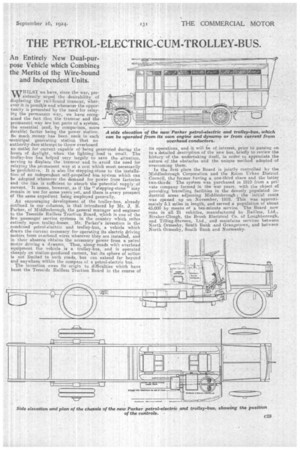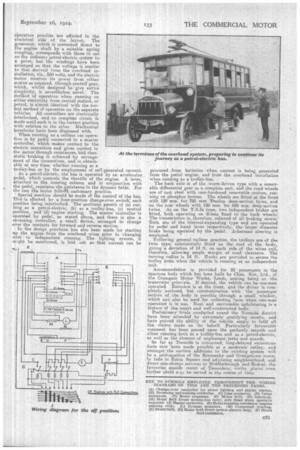THE PETROL-ELECTRIC-CUM-TROLLEY-BUS.
Page 9

Page 10

Page 11

If you've noticed an error in this article please click here to report it so we can fix it.
An Entirely New Dual.purpose Vehicle which Combines the Merits of the Wire-bound and independent Units
WITILSIC we have, since. the war, persistently urged the desirability of displacing the raiI-Inciund tramcar, wherever it is possible and whenever the opportunity is preSentecl by the need for relaying the permanent way, we have recognized the fact that the tramcar and the permanent way are but parts of a system, the essential (and, by comparison, More durable) factor being the power station. So much money has been sunk in each municipal generating station that no authority dare attempt to throw overboard an outlet for current capable of being generated during the hours of daylight, when the lighting load is small. The trolley-bus has helped ,very largely to save the situation, serving to displace the tramcar and to avoid the need far relaying the permanent way at a cost which must necessarily be prohibitive. It is also the stepping-stone to the 'installation .of an independent self-propelled bus system which can be adopted whenever the demand for power from factories and the like is sufficient to absorb the potential supply of current. It seems, however, as if the " stepping-stone" may remain in use for some years yet, and there is every prospect of the same expedient -being employed generally.
An encouraging development of the trolley-bus, already outlined in our columns, is that introduced by Mr. J. B. Parker, of Middlesbrough, the general manager and engineer to the Teesside Railless Traction Board, which is one of the few passenger service systems in the country which, relies entirely upon trolley-buses. Mr. Parker's invention is the combined petrol-electric and trolley-bus, a vehicle which draws the current necessary for operating its electric driving motors from oierhead wires wherever they are installed, and in their absence obtains the necessary power from a petrol motor driving a dynamo, Thus, along roads with overhead equipment the vehicle is a trolley-bus, and is operated cheaply an station-produced current, but its sphere of action is not limited to such roads„ but can extend far beyond and anywhere within the compass of a petrol-electric bus. The invention owes its origin to difficulties which have beset the Teesside Railless Traction Board in the course of
A side elevation can be operated
its operations, and it will be of interest, prior to passing on to a detailed description of the new bus, briefly to review the history of the. undertaking itself, in order to appreciate the nature of the obstacles and the unique method adopted of overcoming them. In the first place the Board is jointly controlled by the Middlesbrough Corporation and the Eaton Urban District • Council, Um former having a one-third share and the latter two-thirds. The system was purchased in 1919 from a private company formed in the war years, with the object of providing travelling facilities in the densely populated industrial areas adjoining Middlesbrough; the initial route was opened up on November, 1919. This was approximately 5.1 miles in length, and served a population of about 45,000 by means of a ten-minute service. The Board now runs in all 21 vehicles, manufactured by Railless, Ltd., Straker-Clough, the Brush Electrical Co. of Loughborough, and Tilling-Stevens, Ltd., and maintains services between North Ormesby, South Bank and Grangetown, and between North Ormesby, South Bank and Normanby. Some time ago Mr. Parker saw the necessity for providing transport facilities in order to develop new districts lying beyond the range of the existing trackless system termini, but at the outset was confronted with road difficulties and the high expenditure which would be necessary. The cost factor has also deterred many other municipal, urban, and other authorities operating railless-car systems from making the fullest advancement of late years, so that Mr. Parker's solution of the problem will create considerable interest. The trolley-bus system is cheaper to install than the tramway and tramcar, but, even then, where developments are contemplated into comparatively thinly peopled neighbourhoods, the amount of revenue likely to be obtained does not justify expensive extensions.
The radius of operations of both trams and trolley-buses is strictly limited, and the alternative of putting into service a fleet of omnibuses into these prospective new areas in order to act as feed arms to existing systems brings one again to the cost question, for here, again, there is the question of whether the criginal outlay will be recovered, whilst a disadvantage of such a scheme is that of having two entirely distinct types of conveyance each performing the same task, It was this combination of circumstances which prompted Mr. Parker to investigate the possibilities of a dual-method machine, and the outcome is the new and completely satisfactory bus now in service on Teesside. One of the most striking features of the vehicle is its absolute simplicity of control, and by reason of its unique construction and capabilities it eliminates disadvantages peculiar to each of the units which it embraces. Whilst actually operating on power deriveli from the overhead wires, it can be run at materially reduced cost, on account of the cheapness of current from the central power station, whilst when working beyond the termini it is as economical in operation as the standard petrohelectric. The vehicle already delivered to the hoard has been manufactured by Tilling..8tevens Motors, Ltd., of Maidstone, and has been designed on the lines of their T.S.5a-type chassis with a 40 h.p. engine. It is designed to carry a maximum load of 5 tons, including the body, and the frame is of pressed steel throughout. The interesting departures necessary to make trolley-bus operation possible are effected in the electrical side of the layout. The generator, which is connected direct to the engine shaft by a suitable spring coupling, corresponds with those in use on the ordinary petrol-electric system to a point, but the windings have been arranged so that the voltage is similar to that derived from the overhead installation, viz., 550 volts, and the electric motor receives its power from either source as required, through control gear, which, whilst designed to give entire simplicity, is nevertheless novel. The method of operation when running on either electricity from central station, or petrol, is almost identical with the normal method of operation on the separate vehicles. All controllers are electrically interlocked, and no complete circuit is made until each is in the correct position with relation to the other. Mechanical interlocks have been dispensed with. When running as a railless car operation is by pedal connected to a master controller, which makes contact to the electric contactors and gives current to the motor through resistances, 'and rheostatic braking is achieved by arrangement of the connections, and is obtainable at any time, whether running as a trolley-bus or by the employment of self-generated current. As a petrol-electric, the bus is operated by an accelerator pedal, which controls the throttle of the engine, A lever, attached to the steering column and in conjunction with the pedal, regulates the resistance in the dynamo fields. For the rest the motor follovh customary practice.
Special mention should be made of the control of the bus. This is effected by a four-position change-over switch; each position being interlocked. The positions permit of (a) running as a petrol-electric, (b) as a trolley-bus, (c) neutral position, and (d) engine starting. The master controller is operated by pedal, as stated above, and there is also a reversing controller, a small device, arranged to change over the contacts for forward and reverse motion.
In -the design provision has also been made for starting up the engine from the overhead wires prior to changing over to independent running. The lighting system, it might be mentioned, is laid out so that current can be
procured from batteries when current is being generated from the petrol engine, and from the overhead installation when running as a trolley-bus. • The back axle is of the worm-driven type with a removable differential gear as a complete unit, and the road wheels are of cast steel with case-hardened renewable centres, run
ning on phosphor bronze. The wheels are fitted at the front with 120 mm. for 720 mm. Dunlop deep-section tyres, and
on the rear wheels with 120 mm. for 850 mm. deep-section twins, As on the T.S.3a type, two independent brakes are fitted, both operating on drums fixed to the back wheels.' The transmission is, therefore, relieved of all braking strain: Both are of the internal-expanding type and are operated by pedal and hand lever respectively, the larger diameter brake being operated by the pedal. Ackerman steering is employed. Following general railless practice, the trolleys are of the twin type, substantially fitted on the roof of the body,
giving a deviation of 14 ft. on each side_of the -wires and, therefore, allow* ample margin of road clearance. The turning radius is 54 ft. Hooks are provided to secure the trolley arms when the vehicle is running as an independent unit.
Accommodation is provided for 32 passengers in the spacious body which has been built by Chas. Roe, Ltd., of the Crossgate Motor Works, Leeds, seating being or. the transverse principle. If desired, the vehicle can be one-man • operated. Entrance is at the front, and the driver is completely enclosed, but communication with the passenger section of the body is possible through a. small window, which can also be used for collecting fares when one-man operation is in use. Neat and serviceable upholstering is a feature of the smart and well-constructed body.
Preliminary trials condticted round the Tee.sside district have been attended by extremely gratifying results, and have proved the ability of the vehicle amply to fulfil all the claims made on its behalf. Particularly favourable' comment has been passed upon the perfectly smooth and silent running both as a trolley-bus and as a petrol-electric, as well as the absence of unpleasant jerks and sounds.
So far as Teesside is concerned, long-delayed extensions have now been made possible at a moderate outlay, and amongst the earliest additions to the existing system will be a prolongation of the Normanby and Grangetown route; to take in Eston Square and adjoining neighbourhood, and direct non-change services to Middlesbrough and Redcar, the favourite seaside resort of Teessiders, wnilst places even farther afield Tr ay be served in the course of time.




























